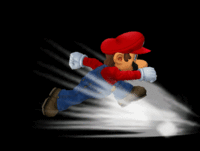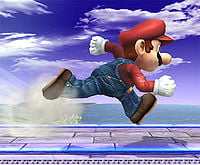Dash
- "Run" redirects here. For information on the CPU mode in Brawl, see List of CPU modes.
A dash is a form of ground movement faster than walking. It is performed by tapping sideways on the control stick. The player's character enters his or her initial dash animation, in which they change directions with very little lag, and then proceeds to his or her running animation. In Brawl, a character attempting to dash can trip instead. While dashing, characters can also perform their dash attack, shield, or jump. The Bunny Hood item increases a character's running speed. The concept of the initial dash is vital to many forms of ground movement, such as dash-dancing, Fox-trotting, and pivoting.
Other terminology
The initial dash is the first part of a character's dash, during which a character can change directions with only 1 frame of lag. The concept of the initial dash is vital to many forms of ground movement, such as dash-dancing, fox-trotting, and pivoting. However, from Brawl onwards, the window for turning around during an initial dash does not last for the entire dash, making dash-dancing much harder, and fox-trotting is also not entirely dependent on the length of the initial dash. The best example of this is Sheik and Roy, who have nearly identical fox-trots despite Roy's initial dash being over twice as long as Sheik's (17 frames to her 8 frames).
The turn-around animation plays when the character attempts to change directions after their initial dash. Unlike in an initial dash, attempting to turn around during a run can take as long as 51 frames (Marth in Melee), and before Smash 4, it can only be cancelled with a jump or side special in the other direction. However, in Smash 4, the turn-around animation can be cancelled with a forward tilt or a forward smash in the other direction.
A stutter step is the term for when a character begins to dash but stops almost immediately, often used for positioning and mindgames. Along with merely stopping, characters can also dash cancel via a variety of other methods.
The skidding animation plays when the character stops running after their initial dash and attempts to stop their momentum. The length of this animation varies, but shorter lengths are generally preferred, particularly in Smash games where dash cancelling is impossible. For example, in Smash 4, Bowser, Charizard, Ganondorf, and Lucario have extremely short skidding animations, which effectively allows them to do any attack out of their runs with little lag in between, or even seamlessly begin another dash in the opposite direction. Similar to the turn-around animation, this animation can only be cancelled with a jump.
In Super Smash Bros. Melee
Initial dash
Because the initial dash animation translates into the running animation much later than in Brawl, it is a vital tool for movement in general and dash-dancing in particular. During the initial dash, the following actions can be used:
- Altering the speed of the dash with the control stick, most notably backwards to Moonwalk.
- Turning around by mashing the control stick in the opposite direction. Turning around takes one frame during which the character is standing and can do all ground attacks except neutral B. If the control stick stays in a neutral position after this pivot frame, the character will keep standing.
- Pressing A or C-Stick forward/backward during the first 3 frames to do a small step forward smash. This is only possible after dashing forward, not backward.
- Pressing A after the first 3 frames to do a dash attack.
- Pressing L or R to shield. During the first two frames of a forward dash, L/R always trigger a roll. On frame 3, they trigger the shield, but with 1 frame delay.
- Pressing L+A, R+A or Z to do a dash grab.
- Jumping and jump cancelling.
- Using forward special.
Run
During the run — the later part of the dash — different options are available:
- Pressing down to crouch. (Spending 1 frame in the RunBrake animation is necessary before the crouch can start.)
- Turning around by mashing or pushing the control stick in the opposite direction. Turning around takes very long, up to 51 frames (Marth). During the turnaround animation, only a jump can interrupt it.
- Pressing A or C-Stick forward/backward during the first 3 frames to do a small step forward smash. This is only possible after dashing forward, not backward.
- Pressing A to do a dash attack.
- Pressing L or R to shield.
- Pressing L+A, R+A, or Z to do a dash grab.
- Jumping and jump cancelling.
- Using special moves.
Running speed
Running speed is the rate at which a character can run.
Super Smash Bros. rankings
| Rank | Character | Running speed |
|---|---|---|
| 1 | Captain Falcon | 70 |
| 2 | Fox | 60 |
| 3 | Pikachu | 55 |
| 4 | Samus | 54 |
| 5 | Yoshi | 50 |
| 6-7 | Donkey Kong & Kirby | 48 |
| 8 | Mario | 44 |
| 9-10 | Link & Jigglypuff | 42 |
| 11-12 | Luigi & Ness | 40 |
Taken from Antdgar's Frame Data
Super Smash Bros. Melee rankings
| Rank | Character | Speed |
|---|---|---|
| 1 | Captain Falcon | 2.3 |
| 2 | Fox | 2.2 |
| 3-5 | Marth, Sheik, & Pikachu | 1.8 |
| 6 | Pichu | 1.72 |
| 7 | Roy | 1.61 |
| 8-10 | Young Link, Yoshi, & Donkey Kong | 1.6 |
| 11-15 | Falco, Dr. Mario, Mario, Mr. Game & Watch, & Bowser | 1.5 |
| 16-20 | Samus, Kirby, Mewtwo, Ice Climbers, & Ness | 1.4 |
| 21 | Ganondorf | 1.35 |
| 22 | Luigi | 1.34 |
| 23-24 | Link & Peach | 1.3 |
| 25-26 | Jigglypuff & Zelda | 1.1 |
Super Smash Bros. Brawl rankings
| Rank | Character | Speed |
|---|---|---|
| 1 | Sonic | 3.5 |
| 2 | Captain Falcon | 2.18 |
| 3 | Fox | 2.08 |
| 4 | Zero Suit Samus | 1.93 |
| 5 | Sheik | 1.92 |
| 6 | Meta Knight | 1.847 |
| 7 | Charizard | 1.8 |
| 8 | Pikachu | 1.765 |
| 9 | Diddy Kong | 1.721 |
| 10 | Marth | 1.7 |
| 11 | Yoshi | 1.68 |
| 12 | Toon Link | 1.65 |
| 13 | Donkey Kong | 1.622 |
| 14 | Pit | 1.583 |
| 15 | Mr. Game & Watch | 1.553 |
| 16 | Bowser | 1.527 |
| 17-20 | Ivysaur, Lucas, Mario, & R.O.B. | 1.5 |
| 21 | Samus | 1.445 |
| 22 | Falco | 1.432 |
| 23 | Lucario | 1.414 |
| 24-25 | Olimar & Wolf | 1.4 |
| 26 | Ness | 1.393 |
| 27 | Ice Climbers | 1.388 |
| 28-29 | Ike & Kirby | 1.371 |
| 30 | Squirtle | 1.37 |
| 31-33 | Peach, Snake, & Wario | 1.35 |
| 34 | Luigi | 1.34 |
| 35 | Link | 1.328 |
| 36 | Zelda | 1.224 |
| 37 | King Dedede | 1.22 |
| 38 | Ganondorf | 1.16 |
| 39 | Jigglypuff | 1.1 |
Note that several slow runners can use their dash attack to travel a far distance quicker, and some characters have a DACUS to increase mobility. The most notable case of this is Snake, whose DACUS gives him much more stage control and ability to evade opponents.
Super Smash Bros. 4 rankings
| Rank | Character | Speed |
|---|---|---|
| 1 | Sonic | 3.5 |
| 2 | Captain Falcon | 2.32 |
| 3 | Little Mac | 2.24 |
| 4 | Fox | 2.184 |
| 5 | Sheik, Greninja and Zero Suit Samus | 2.1 |
| 6 | Charizard | 2.08 |
| 7 | Yoshi, Meta Knight, and Pikachu | 2.05 |
| 8 | Diddy Kong and Palutena | 2.016 |
| 9 | Bowser | 2.0 |
| 10 | Cloud, Marth and Lucina | 1.97 |
| 11 | Roy, Toon Link, Donkey Kong, and Mii Brawler | 1.95 |
| 12 | Mewtwo and Palutena | 1.9 |
| 13 | Pit, Dark Pit and Rosalina | 1.888 |
| 14 | Ryu, Mario, Bayonetta and Duck Hunt | 1.86 |
| 15 | R.O.B. | 1.85325 |
| 16 | Mr. Game & Watch | 1.824 |
| 17 | Shulk | 1.792 |
| 18-19 | Luigi, Samus, Kirby, Ike, Mii Swordfighter, Lucas, Wario and Pac-Man | 1.785 |
| 20 | Lucario, Ness, Corrin and Mega Man | 1.7325 |
| 21 | Olimar and Falco | 1.72 |
| 22 | Bowser Jr. and Peach | 1.7031 |
| 23 | Link | 1.696 |
| 24-25 | King Dedede | 1.66215 |
| 26 | Dr. Mario | 1.632 |
| 27 | Zelda | 1.63 |
| 28-30 | Villager | 1.6 |
| 31 | Ganondorf and Mii Gunner | 1.57 |
| 32 | Robin and Jigglypuff | 1.568 |
Update history
1.1.3
 Kirby's dash speed: 1.5 → 1.57
Kirby's dash speed: 1.5 → 1.57 Mewtwo's dash speed: 1.696 → 1.9
Mewtwo's dash speed: 1.696 → 1.9
1.1.5
 Corrin's dash speed: 1.5 → 1.45
Corrin's dash speed: 1.5 → 1.45 Mewtwo's dash speed: 1.9 → 2.05
Mewtwo's dash speed: 1.9 → 2.05
See also
Trivia
- There are some strange inconsistencies for some characters' running speeds:
- Wolf and Falco dash slower than Fox, despite being faster than him in Star Fox: Assault.
- Ike is a generally slow character in the Smash games, despite having good speed stats in Fire Emblem: Path of Radiance and Radiant Dawn.
- Lucario dashes significantly slower than Pikachu and Ivysaur despite the former having the same base Speed stat and the latter being slower in the Pokémon games.
- Also, in Pokémon, Mega Lucario gets a slight speed increase, but does not in Smash.

